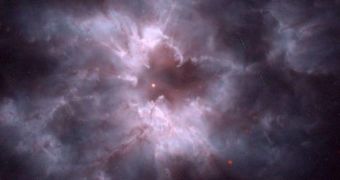After having lived full lives, the two components of a binary white dwarf system are now in the process of merging with each other. This will result in the formation of a new star, which will then go on to live a second full life.
The discovery was made by a team ODF experts led by Harvard-Smithsonian Center for Astrophysics (CfA) astronomer Mukremin Kilic. The binary star system is called SDSS J010657.39 – 100003.3.
It can be found in the direction of the constellation Cetus, at a distance of about 7,800 light-years from Earth, which is near in astronomical terms. The system contains two helium-burning stars.
White dwarfs are the remaining, collapsed cores of Sun-like stars that have reached the end of their burning cycle. As this happens, a yellow dwarf expands into a red giant, which then goes on to shed the outer layers of its atmosphere.
As this happens, the core shrinks, and loses its ability to sustain nuclear fusion because it has no hydrogen fuel left. Therefore, all that's left is a concentration of helium, which the newly-formed white dwarfs go on to consume over a period of about 3 billion years.
Generally, when the helium is depleted, the stars slowly extinguish, but this is not the case in this particular system. Rather, its components spin very close to each other. It takes one of them 39 minutes to carry out a full rotation around the other.
Astronomers now estimate that the two objects will slowly begin to merge, which will eventually lead to the formation of a new star. The process will span over the duration of several millions of years.
In the SDSS J010657.39 – 100003.3 system, astronomers can only observe a single white dwarf, but the existence of a companion has been determined by its gravitational influence on the visible star.
Calculations put the distance between the two celestial bodies at as little as 140,000 miles, which is less than even that distance between our planet and the Moon. The stars travel at 1 million miles per hour, and experts estimate they will need 39 million years to merge.
The binary system also produces what are known as gravitational waves, ripple-like distortions in spacetime that have been predicted by Albert Einstein's theory of general relativity.
Usually, white dwarfs explode as supernovae when they collide, but this can't happen in this particular system because the combined masses of the two stars is not heavy enough to allow for such an event.
Two white dwarfs need to weigh at least 40 percent the mass of the Sun in order to go supernova, but these two are significantly lighter than that, Daily Galaxy reports.

 14 DAY TRIAL //
14 DAY TRIAL //